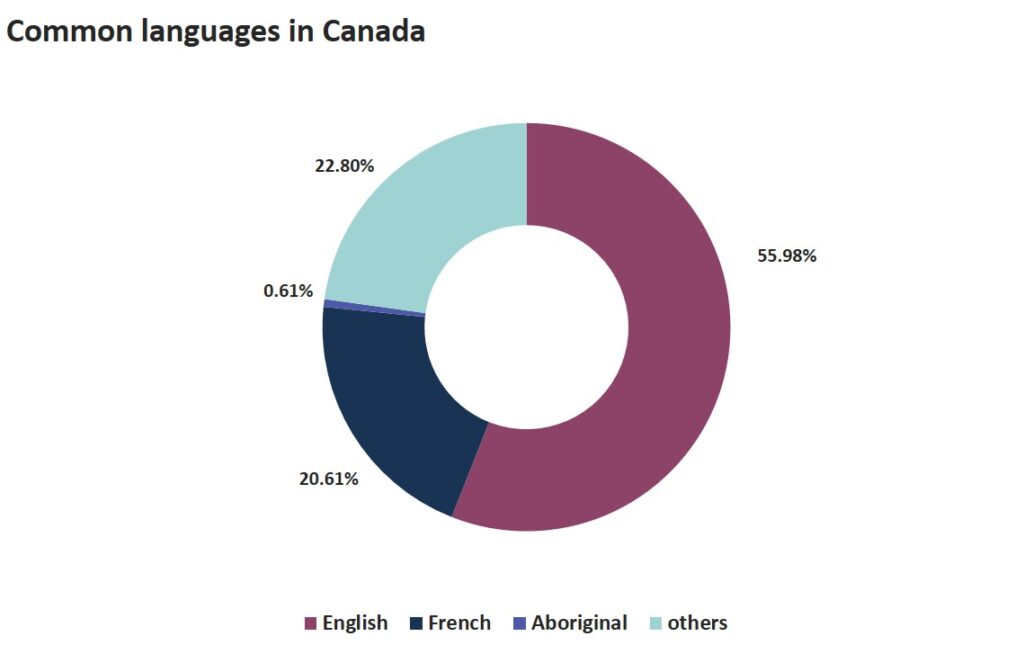
Canada’s Spoken languages; A Fair Amount of Linguistic Diversity to be found

To no one’s surprise, English and French are Canada’s official languages, but did you know that over 200 languages worldwide are spoken in Canada. Keep reading if you want to learn more about the top spoken languages in Canada. Here is a breakdown of Canada’s spoken languages and a quick look at ethnics’ origins.
Table of Contents
Do you know the Canada’s spoken Languages?
Based on the Census in 2016, the mother tongue of 55.97% and 20.61% of Canadians are English and French, respectively. According to the Official Languages Act of 1969, these two languages have official federal status in Canada concerning constitutional entrenchment.
New Brunswick is the only province where English and French are both known as their official languages. However, 22.8% of the population reported speaking other languages. In addition to the cases mentioned above, Canada is home to many indigenous people who speak indigenous languages spoken by less than one percent of the population. The bellow pie chart shows the main percentage of the spoken languages in Canada:
English: 55.97 % native speakers in Canada’s total population
You will probably do just fine if you travel to Canada with some working knowledge of English. This language is one of two official Canada’s spoken languages. About 86 % of Canadians can conduct a conversation in English, which is the overwhelming majority language in Canada.
French: 20.61 % native speakers in Canada’s total population
One of the most important Canada’s spoken languages is French. About 29 % of Canada’s people have a working knowledge of French.
Other immigrant’s languages: 22.80 of Canada’s total population
It is fair to say that there are strong Asian influences, and there is a fastest-growing number of people speaking Asian languages, such as the Philippines, Arabic, Persian, etc. Overall, the European languages, such as Spanish, Italian, German, etc., are the next most common of Canada’s spoken languages.
Aboriginal languages: 0.61 % native speaker of total Canada’s spoken languages
The number of people who speak in aboriginal languages is more than those whose mother tongue is aboriginal. It means that more people learn this language as their second language.
The following table shows the exact percentages of common Canada’s spoken languages by province based on the 2016 census:
| Geographic name | English (%) | French (%) | Aboriginal (%) | Others (%) |
| Canada | 55.97 | 20.61 | 0.61 | 22.8 |
| Newfoundland and Labrador | 96.9 | 0.46 | 0.53 | 2.11 |
| Prince Edward Island | 90.77 | 3.45 | 0.05 | 5.73 |
| Nova Scotia | 91 | 3.23 | 0.5 | 5.27 |
| New Brunswick | 64.2 | 31.39 | 0.32 | 4.09 |
| Quebec | 7.45 | 77.1 | 0.58 | 14.86 |
| Ontario | 66.87 | 3.69 | 0.19 | 29.25 |
| Manitoba | 71.39 | 3.21 | 2.6 | 22.81 |
| Saskatchewan | 82.4 | 1.39 | 2.9 | 13.31 |
| Alberta | 74.29 | 1.79 | 0.67 | 23.24 |
| British Columbia | 68.94 | 1.25 | 0.23 | 29.58 |
| Yukon | 81.86 | 4.42 | 2.32 | 11.4 |
| Northwest Territories | 76.76 | 2.83 | 11.95 | 8.46 |
| Nunavut | 30.88 | 1.67 | 65.23 | 2.23 |
Did you know that more than 250 ethnic origins were reported in Canada’s census?
Now that you have learned about Canada’s spoken languages let’s look at Canada’s ethnic origins and see the most significant origins in Canada. In 2016, the Canadian population reported over 250 ethnic origins or ancestries. In this census in 2016, the most influential ethnic origin is Canadian with 32% of the people, followed by English, Scottish, French, Irish, German, Chinese, Italian, First Nations, and Indian. Also, four in 10 people reported more than one origin per the demographic data collected through a country-wide census in 2016.
Canada’s population estimated around a 5.0 percent increase compared to the last census. Canada is a country with the highest rate of immigration globally, and the main reason for population growth in this country is immigration. Most of the admitted immigrants to Canada were Asian in 2019, mainly settling in Toronto, Montreal, and Vancouver. Also, about 10 percent of annual global refugee resettlements belong to Canada.
Did you know that more than two million of the Canadian population reported Aboriginal origins?
Aboriginal people who provide an exceptional contribution to Canada’s diversity of cultural heritage said 6.2 % of the total Canadian population with three main Aboriginal groups, First Nations or North American Indians, was the largest group, with 1.5 million people. Six hundred thousand people reported Métis origin, and Inuit origin was said by 79,125.
Last lines on Canada’s spoken languages
As you read, English and French are the top used languages in Canada, followed by Asian languages, such as the Philippines, Arabic, and European languages, including Spanish, Italian, and German. So, it’s not surprising if you hear languages other than English and French in public places. We hope that our information has been interesting enough.
Please inform us if you want to know more about Canada’s spoken languages. We look forward to seeing your comments. You can also read more about Canada’s politics, history, economy, and geography.
- https://en.wikipedia.org/wiki/Demographics_of_Canada
- https://en.wikipedia.org/wiki/Languages_of_Canada
- https://www12.statcan.gc.ca/census-recensement/2016/as-sa/98-200
- https://www.statista.com/statistics/271215/ethnic-groups-in-canada/
- https://commons.wikimedia.org/wiki/File:A_group_of_First_Nations_men,_Ontario
- https://commons.wikimedia.org/wiki/File:Pow-Wow_in_Wendake_Canada.jpg





